This post may contain affiliate links. If you use these links to buy something we may earn a commission. Thanks.
At a minimum, all slopes need ground covers to hold the soil together, even on the shady sides. Roots are what keep soils from washing away and allow growth to continue—shine or shadow.
So the question is, what plants will thrive in the shade and offer extensive root systems to your landscape? Trees do a wonderful job, but if larger shrubbery isn’t in the cards for you, plenty of beautiful lower-growing ground covers offer excellent support.
Bugleweed, periwinkle, Japanese spurge, creeping juniper, and creeping phlox are the number one choices for shady hillsides. From dense flowers to evergreen foliage, each ground cover offers unique features.
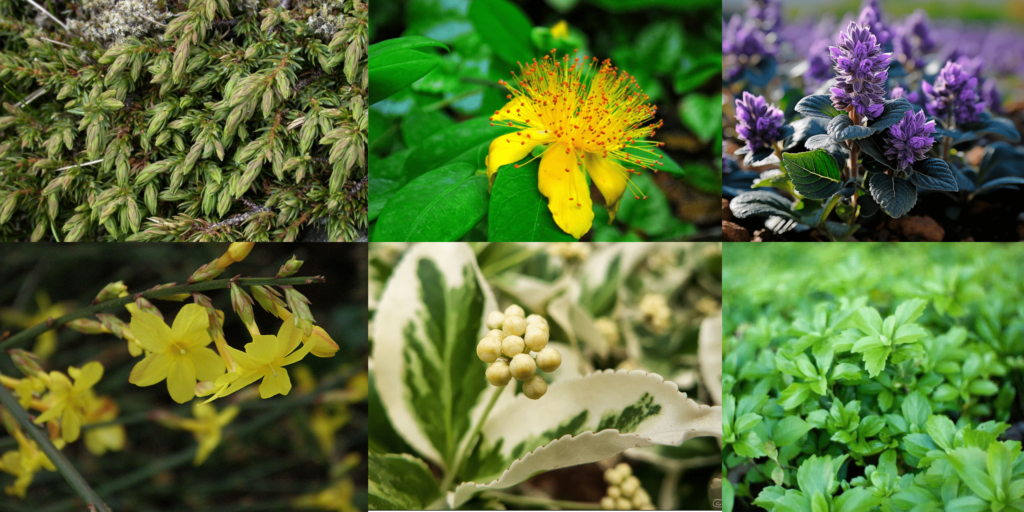
Drought resistance is a vital attribute of any plant you choose for a sloped and low-light space. The plants in this post can grow in dry shade and I would also recommend the post linked below if you need more options.
See: 12 Shade-loving Ground Covers for Droughts & Low Effort
The other side of holding a barren hill together is getting roots in the ground quickly. If time is of the essence, consider fast-growing options. The post linked below will guide you through making a good choice with avoiding invasive species in mind.
See: 16 Fast-Growing Ground Covers to Make Shade Lush
After learning all about the following plants, what other gardeners prefer to grow, and growing several of them myself, I’ve narrowed this list to a mixture of suitable and beautiful options for you to mix and match. By the end, I hope you can choose what will become a beautiful and strong hillside!
Carpet Bugleweed (Ajuga reptans)
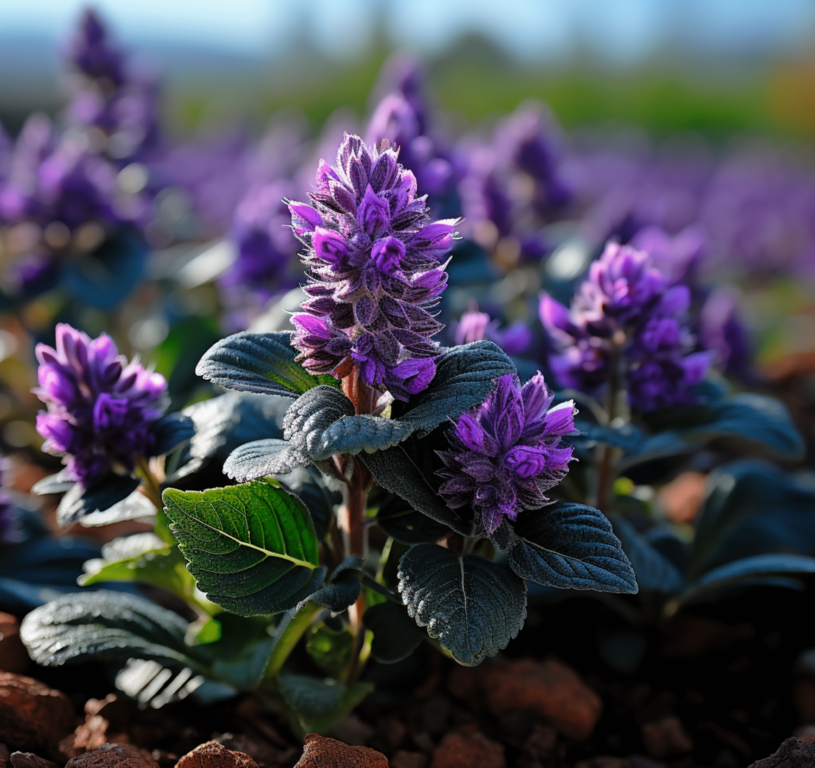
Bugleweed seems to be one of the most versatile and tough ground covers—no wonder it’s a common favorite.
Bugleweed is a go-to ground cover as it thrives in wet or dry conditions and most people plant it just about anywhere.
It forms a dense mat with spikes of blue-purple flowers, has cute creeping foliage, and keeps snug to the ground.
- Height: 4-8 inches.
- Range: Europe, Asia, North Africa.
- Climate: Zones 3-10
- Functions: Attracts bees and butterflies. Edible leaves and shoots. Cute carpeting ground coverage. Medicinal benefits. Ideal for rock gardens, erosion control, low growing ground coverage, and usefulness.
- Light requirements: Full/deep shade to partial shade.
- Soil preferences: Moist or wet soil. Tolerates droughts.
Plants and seeds are available here.
Rose Of Sharon (Hypericum calycinum)
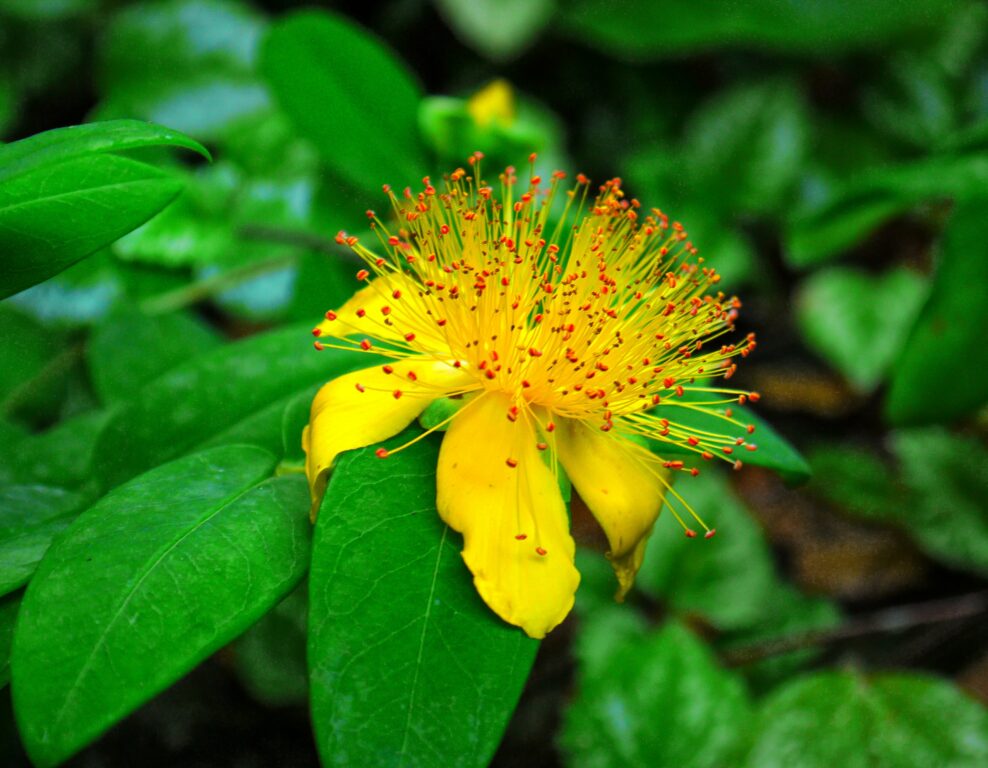
If you’re looking for a showy and low-growing ornamental you’ll love the Rose of Sharon (Hypericum calycinum). Rose of Sharon is a shade lover and grows relatively fast even in dry shade.
Its bright yellow blooms pop against lush green foliage.
- Height: 12-18 inches
- Range: Asia
- Climate: Zones 5-10
- Functions: Used as an ornamental semi-evergreen ground cover. Prevents erosion, is gorgeous when cascading, and attracts butterflies.
- Light requirements: Deep, full, semi, or no shade.
- Soil preferences: Moist or dry soil and drought tolerant. Suitable for heavy clay.
Consider an alternative if invasive in your area, please check before committing.
Nature Hill’s Nursery offers two types of Rose of Sharon (and calls them St. Johns Wort). If you prefer to grow from seed, plenty of options with free shipping are available here.
Winter Jasmin (Jasminum nudiflorum)
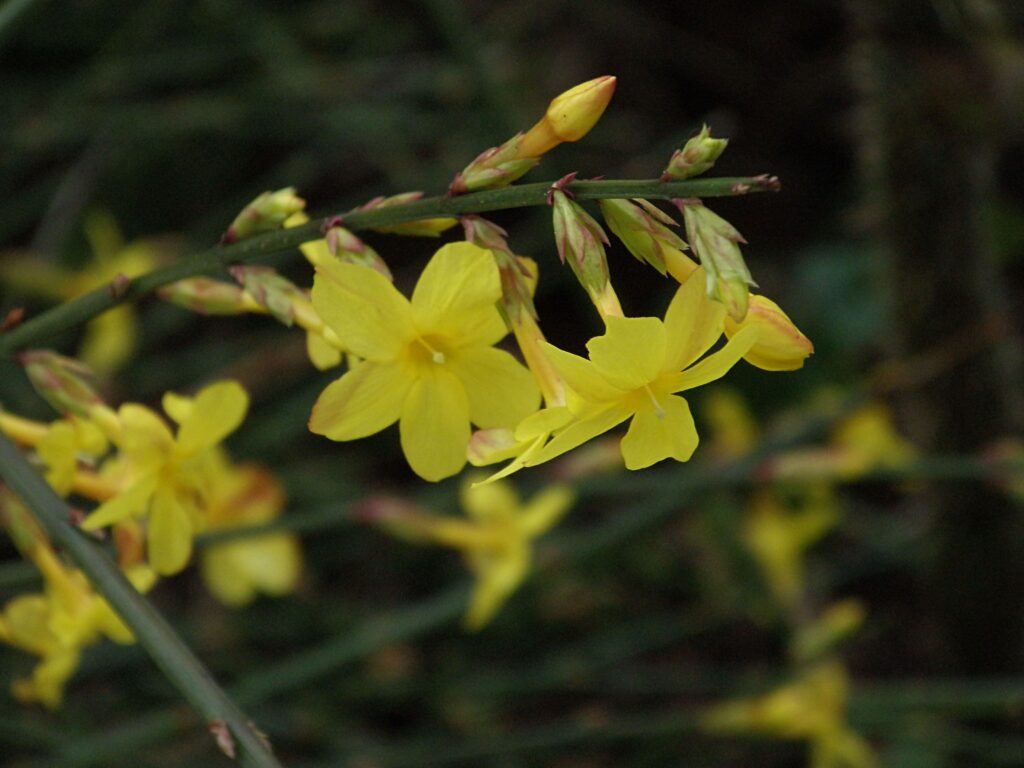
Flowers bloom during warmer spells of winter from December to March—even in North-facing shade! If you need an early bloomer to fill in flowering gaps, this is the one.
Winter jasmin grows with a wide spread of up to 10 feet more which makes it a great ground cover candidate, although it isn’t low-growing. A perfect choice for filling a large or perhaps a crazy-terrain type of space.
- Height: Up to 4 feet
- Range: Asia
- Climate: Zones 6-11
- Functions: Scented ornamental for erosion control or flowers. Used to cascade, climb, or fountain in various garden settings.
- Light requirements: Deep, full, semi, or no shade.
- Soil preferences: Moist soil with good drainage. Suitable for heavy clay.
Both seeds and plant starts are available on Etsy from various sellers with white or yellow flowers. Nature Hills Nursery also offers three varieties in containers here.
Wintercreeper (Euonymus fortunei)
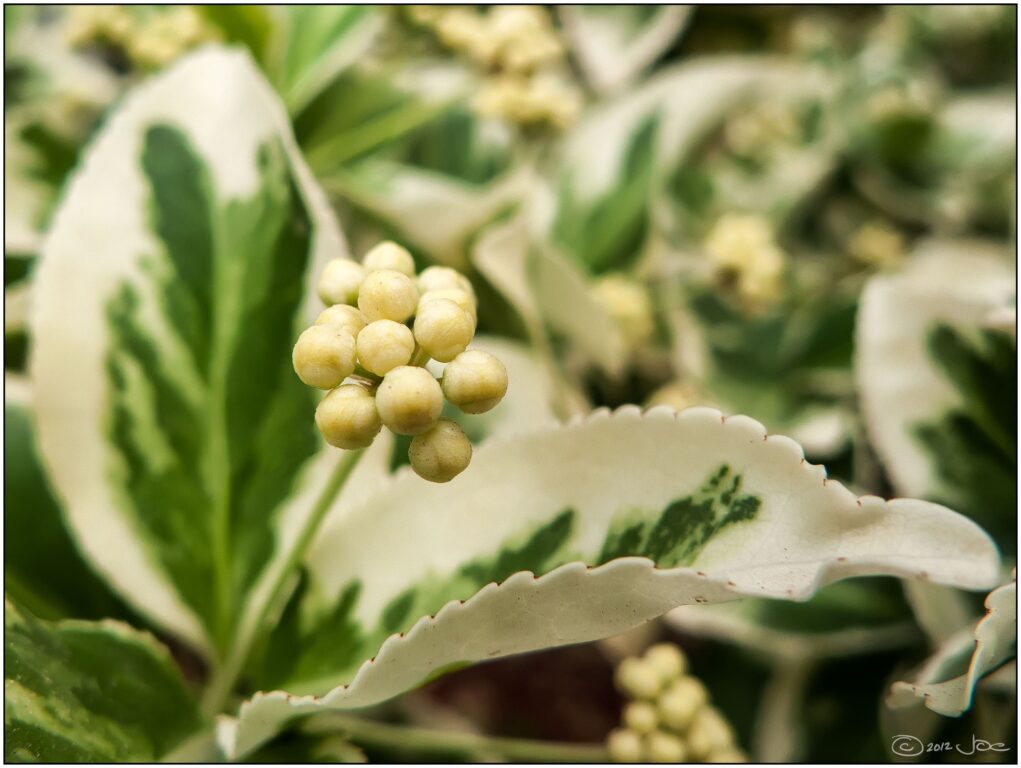
Winter creeper is often used to control erosion with style. The most common varieties are variegated with white known as ‘variegated’ or yellow and green coloring known by the name ‘green and gold.’
- Height: 12-24 inches
- Range: Native to Asia
- Climate: Zones 5-9
- Functions: Evergreen ground cover or low-growing hedge. Can climb or cascade. Prevents erosion.
- Light requirements: Full to partial shade or no shade.
- Soil preferences: Moist soil or dry soil with light to heavy textures. Suitable for heavy clay.
Several varieties of this plant are offered here and seeds or starter plants here.
Shallon (Gaultheria shallon)
Zones 6-9
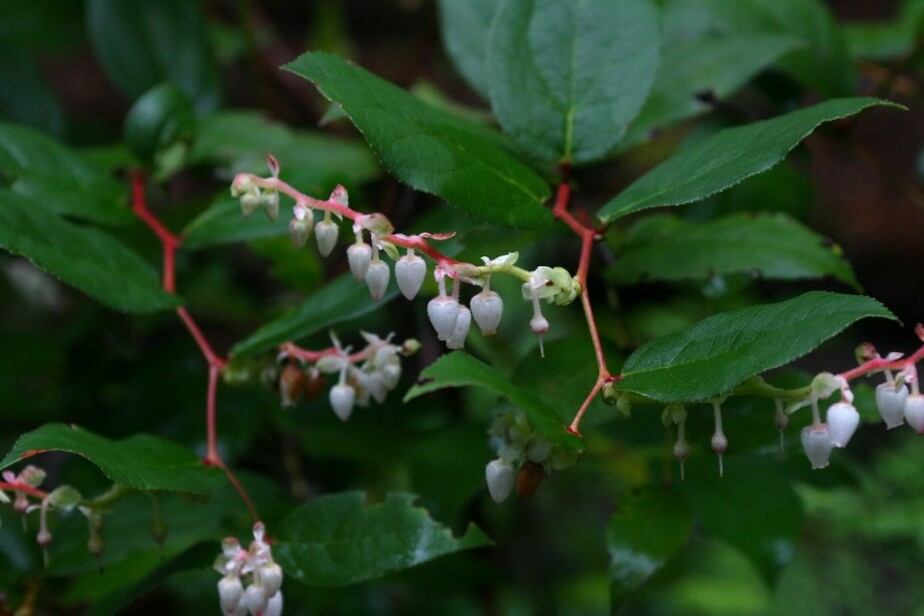
Shallon (or salal) produces sweet and juicy edible fruit and grows well in dappled full shade, part shade, or no shade conditions. An evergreen ground cover shrub that prefers shade or semi-shade in moist, well-drained, and organic-rich soils. Tolerates drought and full sun.
Shallon has a creeping root system often used for erosion control and vigorous spread. A vigorous spread is great for ground coverage and more fruit! With a moderate growth rate, it doesn’t tend to get out of hand too quickly.
Overall, this ground cover is a combination of the most palatable and shade-tolerant of this list!
Bigleaf periwinkle (Vinca major)
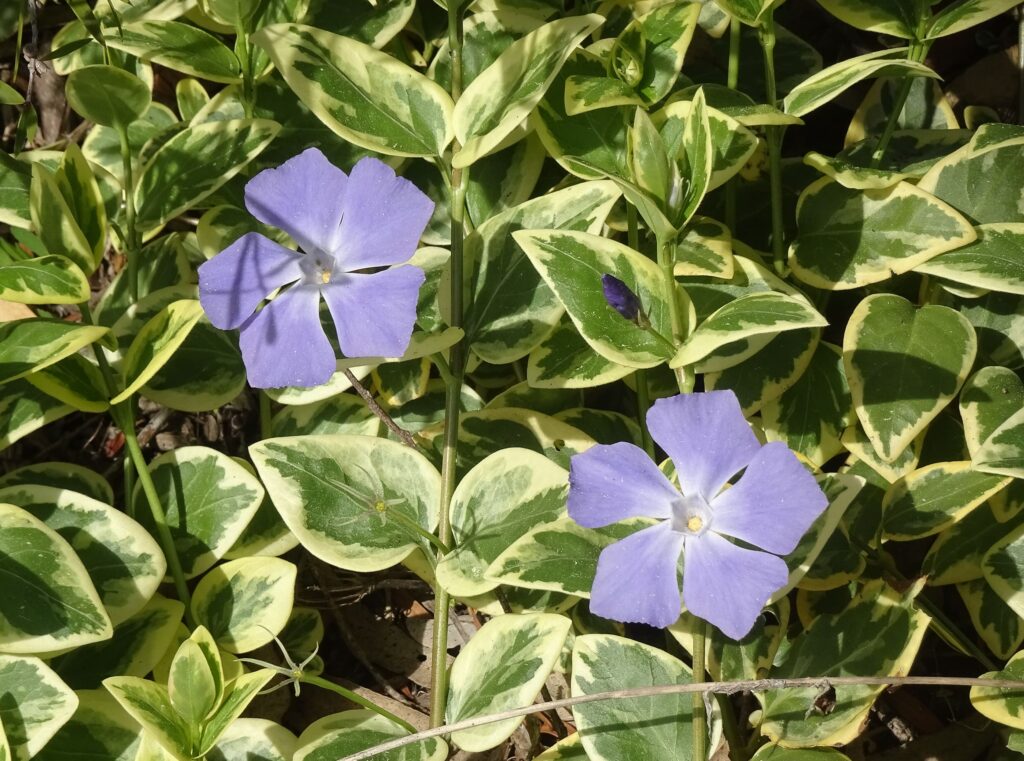
This evergreen vining ground cover grows in all sun levels and is very resilient to dry spells. This vine is often used in “annual” hanging baskets as it beautifully cascades long lengths and withstands quick-drying soils in sun or shade.
In the mild winters of zones 7-9 this perennial is evergreen—keeping its foliage year-round. They flower very well in all but deep shade but are primarily used for erosion control in forest gardens.
- Height: 12-18 inches
- Range: Europe and Africa
- Climate: Zones 7-9
- Functions: Ornamental April to June flowers and vibrant or variegated foliage. Erosion control. Quick ground coverage.
- Light requirements: Full/deep, partial, or no shade.
- Soil preferences: Dry or moist soil and is drought resistant. Suitable for light or heavy soils, including heavy clay.
Seeds and various flower colors are available here and solid green or variegated foliage are available in containers here.
Lesser Periwinkle (Vinca minor)
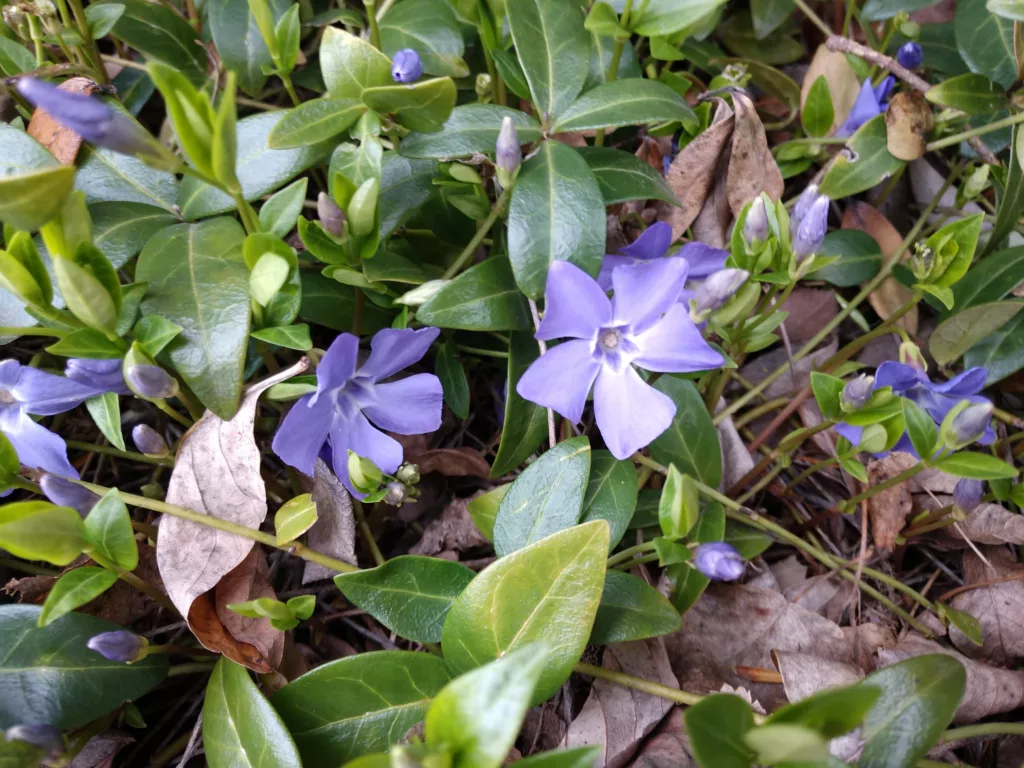
Also called Periwinkle, this is a semi-evergreen ground cover with blue-purple flowers. It’s a fast-growing erosion controller and a popular choice for dry shady spaces.
Although popular, it may be considered invasive or naturalizing in your area.
- Height: 6 inches
- Range: Europe and Asia
- Climate: Zones 4-9
- Functions: Ornamental flowering from April to May with season-round attractive foliage. Erosion controlling ground cover for rock gardens, food forests, steep slopes, shady areas, and borders.
- Light requirements: Full/deep shade to partial shade, or no shade.
- Soil preferences: Moist or dry soil and tolerates drought. Suitable for various soil types including heavy clay.
Plants are available here and seeds are here. Ordering seeds offers pink and other flower colors, but a container allows for quicker establishment.
Japanese Spurge (Pachysandra terminalis)
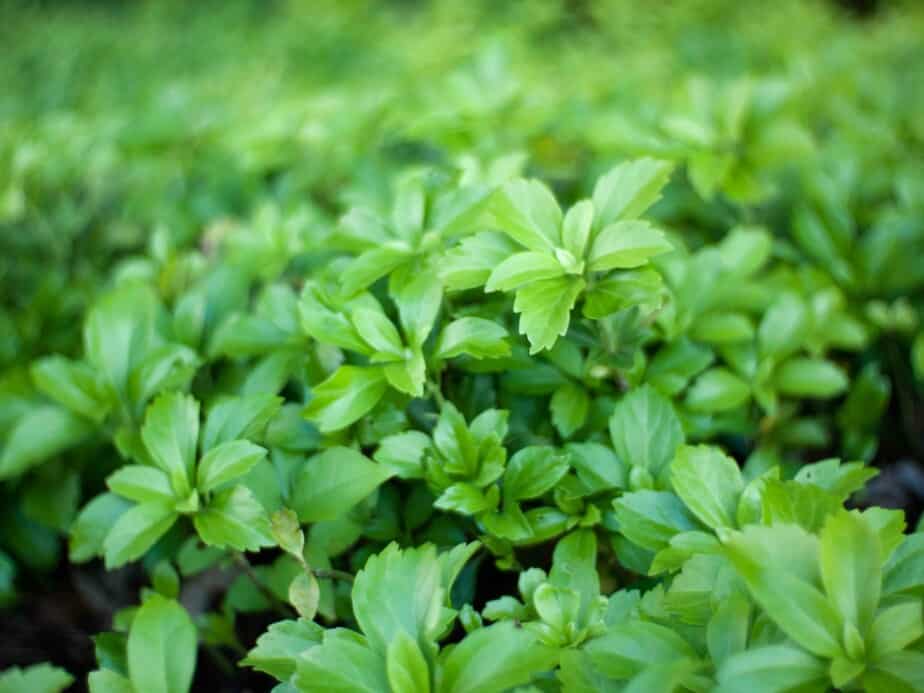
Japanese spurge offers a vibrant and eye-catching texture. It thrives in deep shade or partial shade and offers a dense bright green in darker spaces. While it grows fast, it isn’t invasive beyond the shade.
- Height: 2-8 inches
- Range: Asia
- Climate: Zones 4-8
- Functions: Best used under established shrubs or trees to control erosion, cover exposed soil, or fill gaps around rocks.
- Light requirements: Full/deep shade to partial shade.
- Soil preferences: Dry or moist soil and tolerant to drought.
From April to May, you’ll also enjoy the scent of inconspicuous flowers.
Japanese spurge seeds and cuttings are available here and plants are available here.
Bearberry (Arctostaphylos uva-ursi)
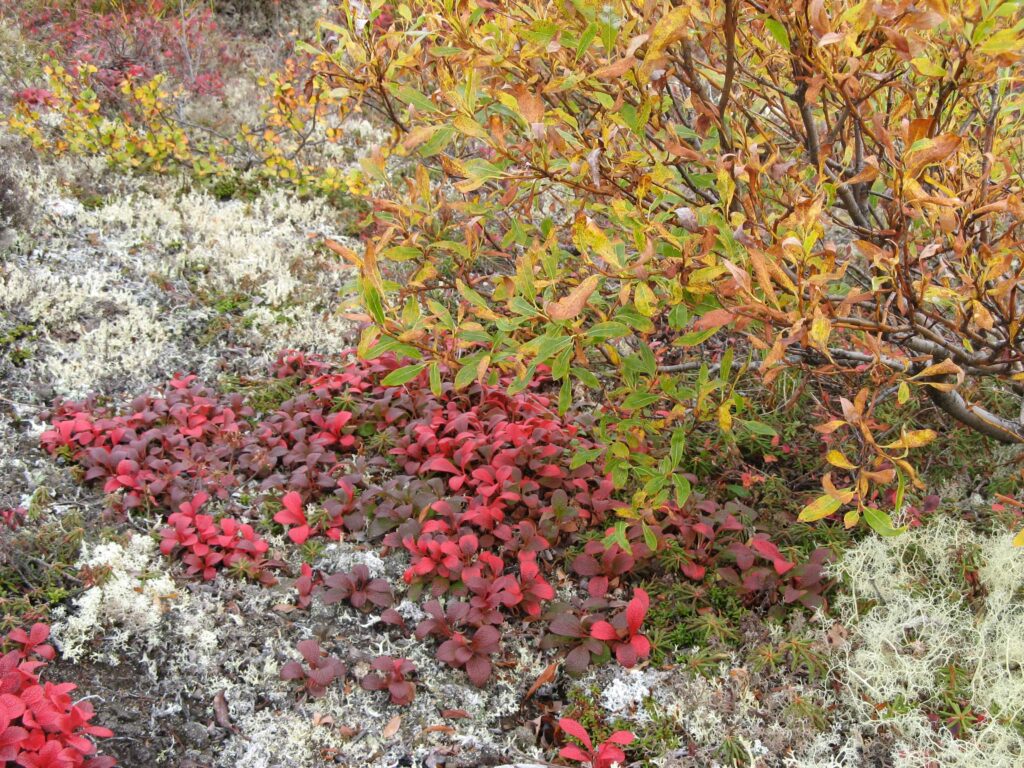
Bearberry plants are popular in food forest gardens as they thrive in all levels of sun from full to partial, or no shade. These highly functional plants offer strength and adaptability to be pioneers, medicinal properties, edible fruit and leaves, and gorgeous coloring.
They offer dark green foliage all year but turn red in fall (as pictured). Foliage stays on year-round in zones 4-8.
- Height: 6-12 inches.
- Range: North America, Britain, Northern Europe, Northern Asia.
- Climate: Zones 4-8
- Functions: Evergreen ground coverage, edible and potentially medicinal, and prevents erosion.
- Light requirements: All light levels from full shade to sun.
- Soil preferences: Moist soil
You’ll find seeds, tinctures, and dried versions of this plant for sale to consume medicinally or grow. Find seeds and the value of this herb!
You can also buy this species as a plant at Nature Hills Nursery—they call it “Massachusetts Kinnikinnick”
Creeping Juniper (Juniperus horizontalis)
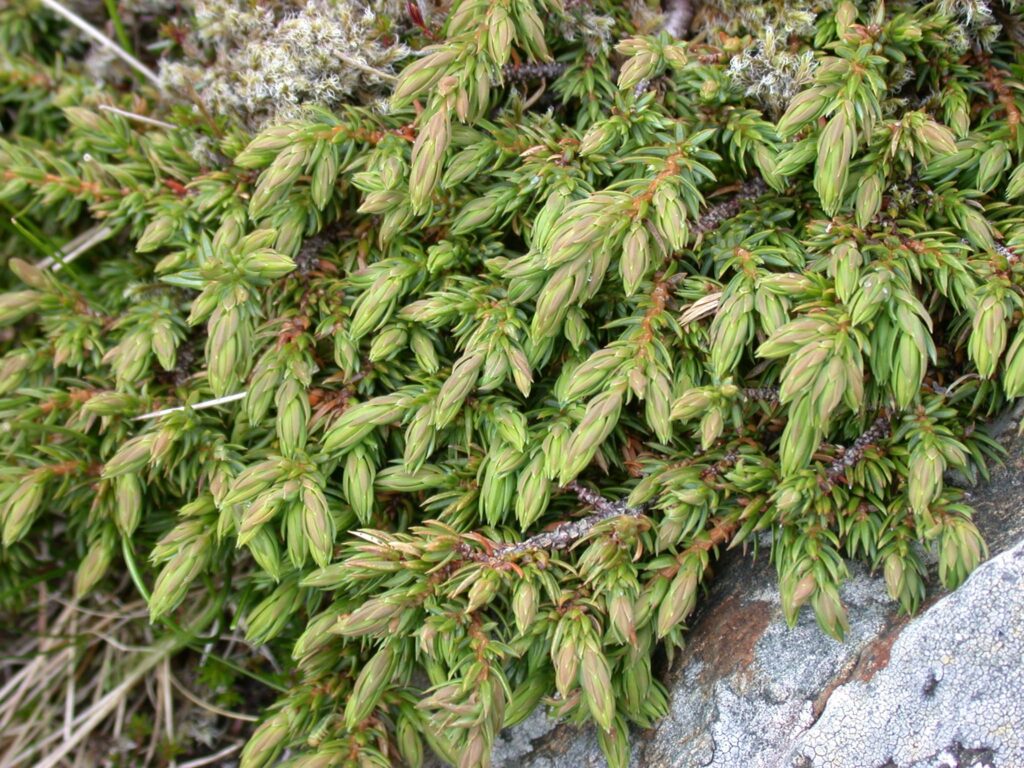
Creeping juniper is a lower-growing evergreen ground cover often used to deter deer or keep a landscape green year-round. Unlike juniper trees, the creeping juniper shrubs can thrive in partial shade.
- Height: 2 feet
- Range: North America
- Climate: Zones 4-9
- Functions: With the definite correct species, the berries and green tips of juniper are edible as beverage ingredients. Juniper is also chosen for erosion control, cascading gardens, native gardens, mass coverage, food forest borders or windbreaks, rock gardens, or along seashores as they tolerate maritime areas.
- Light requirements: Partial shade or full sun.
- Soil preferences: Moist or dry soil with good drainage and tolerates drought.
Junipers are highly versatile and useful ground covers but are a bit taller than what everyone may consider when searching for the ideal ground cover.
If creeping juniper sounds like a good choice for you, plenty of options are available. Lime green or blue-coloring with various foliage patterns.
Shore Juniper (Juniperus conferta)

Most junipers need full sun but shore juniper is tolerant to partial shade. Junipers are a preferred ground cover for an evergreen and deer or rabbit-resilient landscape.
- Height: 10-18 inches
- Range: Native to Asia
- Climate: Zones 6-10
- Functions: Evergreen ground coverage. Edible fruit (on true junipers) is used to make cocktail bitters! Erosion control on slopes.
- Light requirements: Partial or no shade.
- Soil preferences: Moist or dry soil with drainage. Tolerates drought. Suitable for seashores, and shallow or rocky soils.
Also known as ‘pacific blue’ this juniper is available here in containers.
Buffalo Grass (Stenotaphrum secundatum)
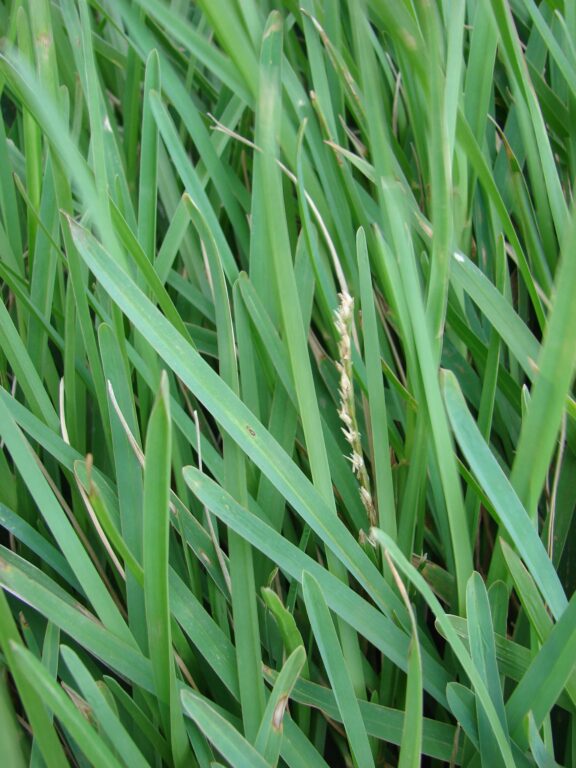
Buffalo grass is very drought tolerant when established and left at longer heights. If you’re looking to fill a spot where grass doesn’t grow, with grass, then buffalo grass will do the job. It’s often used in pastures or to prevent soil loss under trees or near the sea as it tolerates maritime exposure.
- Height: 35 inches
- Range: North & South America
- Climate: Zones 7-12
- Functions: A perfect ground cover for dry shade to prevent erosion and emptiness, or lawn replacement for shaded areas. Conserving soil.
- Light requirements: Full/deep shade to partial shade or no shade.
- Soil preferences: Moist soil and tolerates drought.
Many local areas will have buffalo grass available. Here’s one place that offers it.
Creeping phlox (Phlox stolonifera)
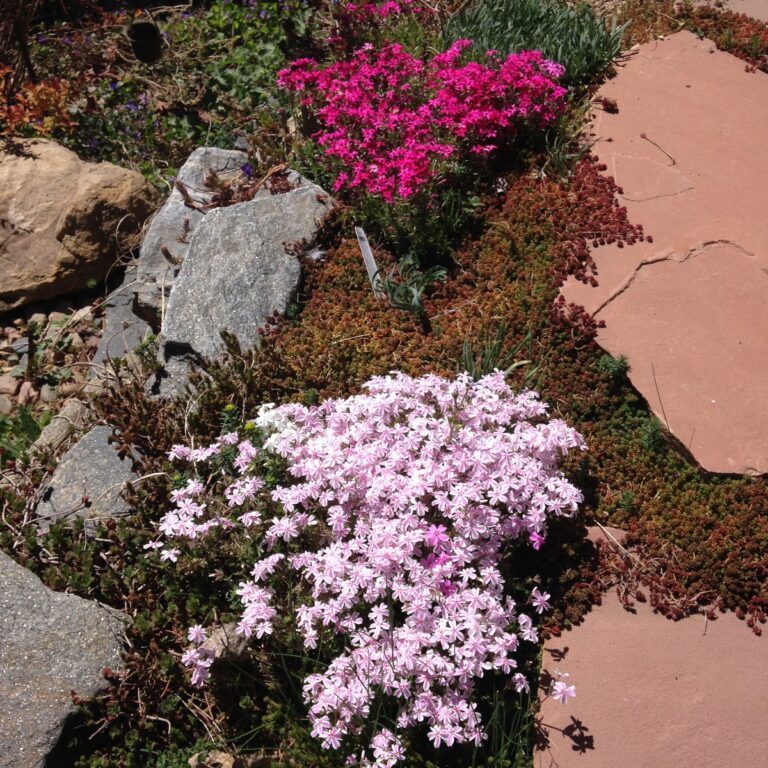
Creeping phlox is functionally similar to wild blue phlox, but is a lower-growing version. This phlox tends to spread easier and cover more ground in less time. This is a better choice for larger spaces in need of dense ground coverage.
The flowers bloom in dense clusters and come in endless colors.
- Height: 3-8 inches
- Range: North America
- Climate: Zones 4-9
- Functions: Best planted when needing a pollinator magnet and gorgeous ornamental ground cover.
- Light requirements: Full/deep shade to partial shade or full sun.
- Soil preferences: Moist soil and drought tolerant.
Etsy offers creeping phlox seeds here and transplants are offered here.
Final thoughts
Any drought-resistant ground cover should be given care during its first year before withstanding extended periods of dryness.
Hillsides allow water to run so fast it doesn’t have the chance to soak into the hillside soil. Instead it all pools at the bottom while the soil on the hill is left bone-dry.
The key to thriving and healthy slopes is to create terraces.
See: Prepare the Ground for a Food Forest Properly (Full Guide)
If terracing isn’t an option, the next best thing is to make a ‘well’ for each plant and provide it with deep watering for the first year as needed. A well is like a small moat around the plant for the purpose of capturing a pool of water. This is where you will pour water to provide roots with a deep soaking.
Deep watering will allow any new transplants to anchor into the hill quickly and grow more foliage. Healthy foliage catches water and allows some to soak into the soil, keeping the plant watered.
As seasons pass, mulch will also help capture and retain water. With this cycle of growth, these plants will have the resources in place to retain water and withstand periods without rain.
Recent Posts
There’s no shortage of full-sun ground covers for zone 4 climates! Each plant in this list can withstand the frigid temperatures and also enjoy the hot sun in summer. Full sun means that a plant...
There's no shortage of full sun ground covers, not even in zone 3! Zone 3 climates offer hot but short-lived summers and very cold winters. So each plant in this list can withstand the frigid...
